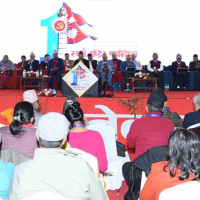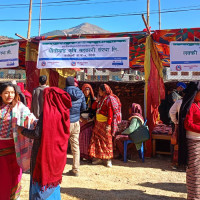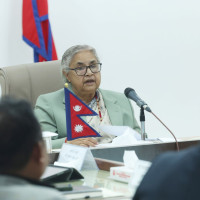- Monday, 15 December 2025
Looma Technology Boon For Underprivileged Students
Technology has played a crucial role not only in imparting quality education but also in expanding teaching and learning activities to the far-flung parts of the country, benefiting the children of marginalised communities. In Nepal, many community schools still lack modern technology essential to providing students with prompt access to resources, information, and materials. As the country’s school education system is still fraught with multiple challenges, Looma technology has come in handy in shoring up the government’s efforts to increase the access of all children to education. Looma technology is gaining ground in dozens of community schools across the country.
Two Stanford University graduates, David Sowerwine, an MBA, and Skip Skitter, who holds a PhD in computer science, deserve appreciation for spreading Looma technology in many schools in Nepal through their non-profit organisation, Looma Education (LEC). It is breaking barriers and transforming the lives of underserved communities with its groundbreaking educational solutions. "We always support Nepal’s education system. We made this technology to help the Nepali students learn better,” says Sowerwine. Looma is an audiovisual projector-based device with low power consumption. Because it has a projector, a computer, a sound system, the entire government curriculum, and a sizable media collection, the device is also known as the ‘world in a box’. It can be used where there is no electricity or an internet connection. All elements of the Looma system (hardware, software, and content) are open source.
Online platform
With Looma’s system, students can access an extensive library of digital resources, including videos, images, interactive games, and quizzes, all mapped to the chapters in their text books. This seamless integration of multimedia resources effectively enhances teaching and learning activities. The device can be operated for more than eight hours without recharging using just 60 W of power, a 12 W solar panel, and a 60 AH battery. The LEC has been collaborating with the government and non-government agencies in Nepal to integrate Looma into the school education system. It also features a free online learning platform that anybody may use where the internet is accessible. It offers a wide range of presentable and easy-to-use lesson-planning capabilities for educators. “It has been providing educational opportunities for those who may not have easy access to traditional resources." Nanda Lal Bhandari of Village Solutions Pvt. Ltd., one of the partners of LEC.
The Looma commenced its journey here with the construction of 38 ’wire bridges’, which provided a safe and economical means for students to access schools around 25 years ago. This initial endeavour highlighted the need for more comprehensive solutions to improve the overall academic environment in these underserved areas. LEC seeks to ensure that the Nepal education community will get to know Looma and then adopt, enhance, and scale the system within their programmes. This will strengthen the community’s long-term capacity to deliver education, especially in schools that lack basic resources. After multiple field trials from 2012 through 2023 and coaching from experienced education organisations, LEC created this interactive A/V delivery system appropriate for Nepal's low-resource, low-budget schools. It continues to grow.
With its user-friendly interface and diverse content, Looma Education aims to provide teachers with the necessary tools to deliver engaging and effective lessons. There are lesson plans available for different grade levels and learning objectives. However, if anyone wants to make their own lesson plan and add it to their device or website, the team does provide training for that as well. All the lesson plans that are on the website at the moment are made by the volunteers on the US team. In 2019, Looma embarked on a pilot programme, targeting 12 schools in Nawalparasi, Lamjung, and Gorkha through the Collaborative School Network (CSN), a partner organisation of Teach for Nepal (TFN). This initiative intends to introduce Looma’s educational solution to these schools and empower them with the tools and resources needed to enhance education in their communities.
However, the COVID-19 pandemic brought unforeseen challenges. Nepal, like many other countries, imposed harsh lockdowns and restricted school operations to curb the spread of the virus. This situation undoubtedly disrupted the plans and efforts of Looma and its partner schools. Despite these challenges, it’s heartening to hear that student in Lamjung and Gorkha made use of Looma’s technology and found it effective. This positive feedback underscores the potential impact of Looma’s educational solutions, even in remote and challenging circumstances. It also highlights the resilience of both the organisation and the communities it serves in adapting to changing conditions and continuing their commitment to education.
Looma device
In 2020, nine devices were distributed to nine schools in Kavre district, including Purna Sanjiwani Lankhanamai Secondary School and Shree Kalidevi Secondary School. Likewise, in 2022, around 11 schools in Gorkha district, nine schools in Lamjung, 12 schools in Kaski district, 2 schools in Tanahu, and one each in Parbhat and Baglung districts will adopt Looma technology. This year, six schools in Nawalpur, three schools in Lalitpur, and one each in Dhading and Rupandehi implemented Looma programmes. The Ministry of Education, Science, and Technology and the Centre for Education and Human Resource Development (CEHRD) monitor the use of Looma online. LEC staff taught many teachers, parents, and other stakeholders nationwide using Zoom. More than 10,000 individuals enrolled, but many of them had more than one person behind the screen.
The number of people who received training on using the learning portal is unknown, given the vast number of Zoom users. After the coronavirus cases subsided, LEC collaborated with the Educational Resources and Development Centre Nepal (ERDCN) and the Rotary Club of Pokhara to install Looma and train teachers and students in 35 different schools. Funds came from the Rotary Club of Woodside/Portola Valley in California and a California foundation. The Looma device was also distributed to nine schools in Dhulikhel as part of LEC's collaboration with the Education Empowerment Centre (EEC), with funding from the German Nepali Help Association (GNHA). Over 14,000 students have benefited from this initiative since it was launched in 42 different schools throughout Nepal from 2019 to 2023.
(Manandhar is a programme coordinator for LEC Nepal Chapter.)















